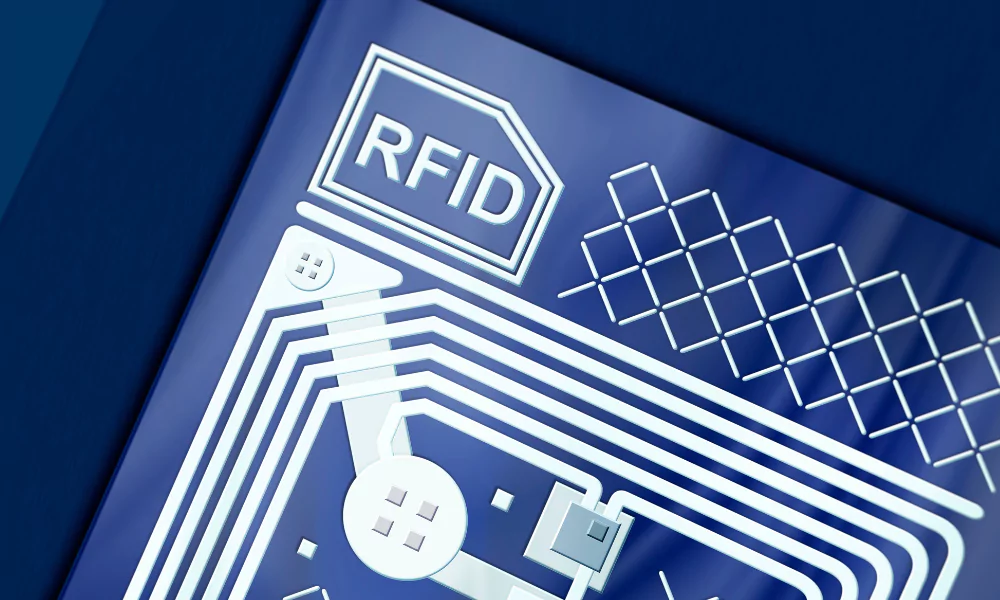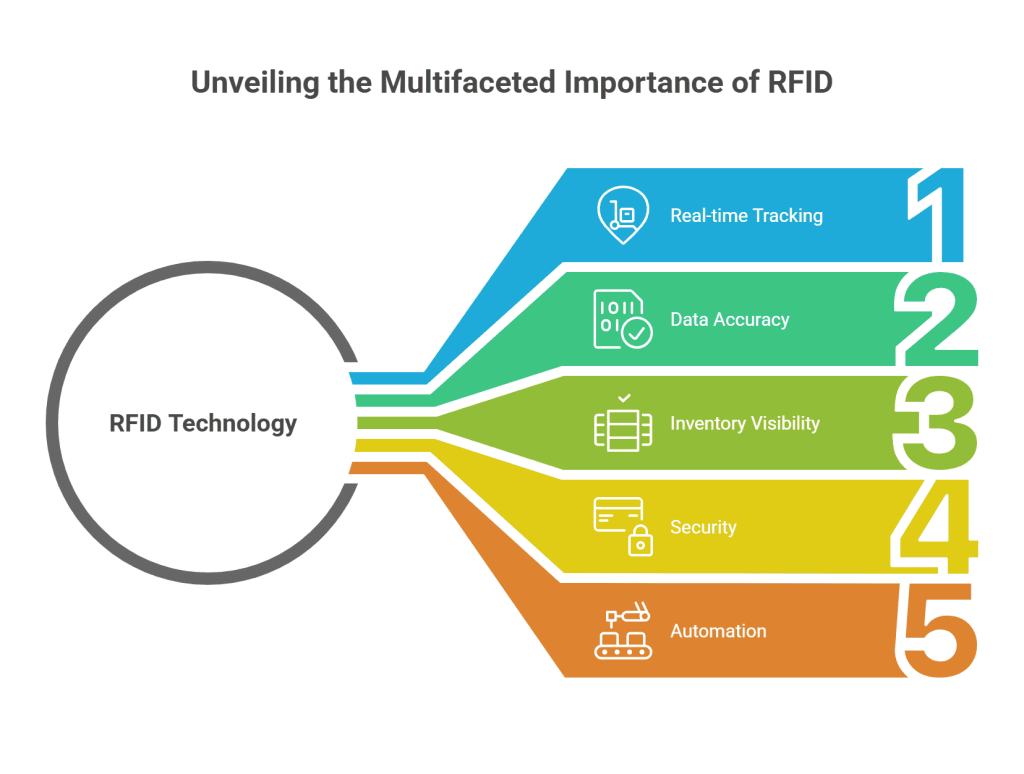Imagine a world where every product, package, or pallet communicates its location, status, and even temperature in real-time.
No, we’re not talking about sci-fi here. This is the direction RFID technology is heading.
As we move into 2025, RFID tags are no longer just basic identifiers. They’re evolving into intelligent tools driving automation, transparency, and efficiency across industries.

From fashion retail to pharmaceuticals and warehouses to smart cities, the rise of smart RFID tags and printable RFID technology is reshaping the very infrastructure of supply chains and beyond.
So, what does the future hold for RFID?
Let’s explore the latest RFID trends, use cases, and the innovative applications pushing the boundaries of what these tiny tags can do.
What Makes RFID So Important Right Now?

Before we jump into the future, let’s quickly recap why RFID technology matters today:
- Real-time tracking: Instantly identify and locate products.
- Data accuracy: Reduces manual entry errors.
- Inventory visibility: Optimizes stock levels and reduces overstocking.
- Security: Helps prevent theft and counterfeiting.
- Automation: Speeds up checkout, audits, and warehouse operations.
Industries are already realizing these benefits, but what’s coming next will amplify them even more.
Emerging RFID Trends to Watch in 2025
Let’s dive into some key RFID trends gaining momentum:
| Trend | What is means | Why it matters |
| Printable RFID | RFID circuitry that can be printed directly on paper or packaging | Reduces cost and enables mass deployment |
| Smart RFID Tags | Tags with added sensors (e.g., temperature, motion) | Ideal for cold chain, healthcare, and food safety |
| Blockchain Integration | Secure RFID data logged on blockchain | Improves traceability and trust |
| Sustainability in RFID | Tags made of recyclable or biodegradable material | Reduces environmental impact |
| Cloud-based RFID platforms | Centralized data and analytics | Drives better business intelligence |
One great example is Zara, the fashion retailer, which uses RFID tags to track every garment in its supply chain – from manufacturing to store shelves. This real-time visibility allows Zara to respond quickly to sales trends and stock availability, maintaining a lean and efficient inventory model.
Now that we’ve looked at trends, let’s move on to practical applications in 2025.
RFID Use Cases You Can Expect to See More Often
The real power of RFID technology lies in how it’s used. Here are some innovative use cases that are becoming more common:

1. Cold Chain Monitoring
Smart RFID tags with built-in temperature sensors help track perishable goods like vaccines, dairy, or seafood. If the temperature crosses a threshold, alerts are triggered in real-time.
2. Automated Retail Experiences
Amazon Go stores are a prime example. Customers pick up products, walk out, and the RFID system automatically bills their account.
3. Healthcare Asset Tracking
Hospitals like the Cleveland Clinic use RFID tags to monitor medical equipment and patient movement, ensuring faster service and equipment utilization.
4. Document & Access Management
Law firms and government offices are tagging files and ID cards for seamless tracking and secure access control.
5.Fleet & Logistics Optimization
Companies like FedEx are experimenting with printable RFID on shipping labels to automate package tracking without bulky scanners.
Speaking of logistics, let’s shift gears and look at how RFID supports future logistics systems.
RFID’s Role in the Future of Logistics
As logistics networks become more dynamic and on-demand, RFID tags are a foundational element. Here’s how they’re transforming future logistics:
- Warehouse Automation: RFID-enabled robots and drones can scan inventory faster than humans ever could.
- Predictive Maintenance: Vehicles tagged with RFID can alert fleets before breakdowns.
- Real-Time ETA Updates: RFID checkpoints provide accurate delivery timelines and improve customer satisfaction.
- Returns Management: RFID simplifies sorting and restocking of returned goods.
Walmart has been pushing RFID into its supply chain aggressively, especially in categories like electronics and apparel. Their adoption strategy involves combining RFID data with AI-driven analytics to cut stockouts and markdowns, proving how scalable this tech can be.
The Rise of Printable and Smart RFID Tags
Two specific types of RFID tags are setting the stage for broader adoption:
1. Printable RFID
- How it works: Conductive ink is used to print RFID circuits directly onto packaging.
- Benefits: Lower cost, less material usage, perfect for high-volume retail or e-commerce.
- Real-world use: CPG brands are beginning to print RFID on individual product packaging for frictionless scanning at checkout.
2. Smart RFID Tags
- How it works: These include tiny sensors for things like temperature, humidity, and movement.
- Benefits: Adds intelligence to tags, improving quality control and predictive insights.
- Real-world use: Pharma companies are using these to ensure vaccine vials haven’t been exposed to unsafe conditions during transit.
These developments are key to achieving full traceability and data-rich supply chains – exactly what future logistics needs.
Tips for Businesses Adopting RFID in 2025
If you’re planning to invest in RFID technology, here are a few tips to make the journey smoother:
- Start with high-value or high-volume products: This ensures ROI comes quicker.
- Don’t overlook integration: Make sure your ERP or WMS can absorb RFID data.
- Think about the environment: For sustainability goals, look into recyclable RFID materials.
- Plan a phased rollout: Test in one facility or product line before scaling.
- Train your teams: Employees must be familiar with how to use and benefit from RFID.
Target, for instance, phased in RFID tagging for home goods and electronics first, then extended to all stores. This approach helped iron out operational issues early.
FAQs: How RFID Technology is Powering Future Logistics
1.What makes RFID better than barcodes in 2025?
RFID allows for bulk scanning without line-of-sight, which saves time and reduces human error – especially with smart RFID tags that provide richer data.
2. Will RFID replace QR codes or barcodes entirely?
Not entirely. Barcodes and QR codes are still cheaper for small-scale use. But with printable RFID becoming more affordable, this might change for larger applications.
3. Is RFID secure?
Yes, especially with encryption and blockchain integration. Many companies are pairing RFID technology with secure cloud systems.
4. Are RFID tags reusable?
Passive RFID tags are typically disposable, but active ones (with batteries) can be reused depending on the application.
Conclusion
The future of RFID tags isn’t just about tracking, it’s about transforming. With smart RFID tags, printable RFID, and real-time intelligence powering future logistics, we’re entering a new era of supply chain visibility and automation.
Big brands are already betting on it. The question is are you ready to keep up?






